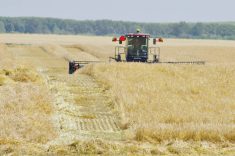Growing organic crops can be tough. Finding reliable buyers even tougher.
A recent matchmaking event was aimed at helping the two sides of the organic supply-and-demand equation meet in the hopes that the industry might go forth, be fruitful, and multiply.
“It’s speed dating,” said Laura Telford, an organic business development specialist with Manitoba Agriculture, Food and Rural Initiatives, which organized the event.
“This is the first time we’ve done it for grain growers. It’s pretty common in the horticulture world to hook up restaurants and market gardeners.”
Read Also

Manitoba sclerotinia picture mixed for 2025
Variations in weather and crop development in this year’s Manitoba canola fields make blanket sclerotinia outlooks hard to pin down
About 40 organic growers gathered in an auditorium at the Brandon GO Office as a handful of buyers stood up one by one to give a short summary of their needs for the coming year. After lunch, growers and buyers could meet for one-on-one talks in private rooms.
Because organic crops aren’t traded on public exchanges, growers need to do some sleuthing to determine forward prices and markets, said Telford. That makes it hard to know what to grow. Asked if they had finalized their seeding plans for this year, only three growers raised their hands.
The lack of a futures market for organic grains can lead to some topsy-turvy situations, said Roger Rivest, who was at the workshop promoting his company, Tilbury, Ont.-based Keystone Grain.
For example, feed-grade organic soybeans were fetching $20 to $22 per bushel, which was higher than food grade at that time.
“It was the first time I’d ever seen that in 25 years,” said Rivest.
Last year’s supplies of corn, soybeans and soft wheat have been bought already, while oats and barley have been “gone for a long time,” he said.
Corn, barley and peas — at $12 per bushel — are likely to be the top organic crops this year, he added. But spelt is in a glut, following its typical three-year cycle of lean and fat years.
“If it goes up to $550 per tonne, everybody grows it and changes their rotation, floods the market, and drives it down to $300 — then they sit on it for three years,” said Rivest. “If the farmers would just follow their rotations, they’d have a stable market.”
Farmers are always calling him to inquire about what to grow, but he advises them to stick to the program.
“Don’t change your rotations,” said Rivest. “One year corn will do well, next year wheat, or spelt, or something else.”
Feed multicrop
In Ontario, a multicrop of oats, barley and peas, which sells for $320 per tonne, has been climbing in popularity. The varieties are chosen for matching days to maturity, then harvested altogether and milled into a complete feed with a vitamin and mineral premix added for organic hogs and poultry.
“The higher the percentage of peas, the more it’s worth due to the protein,” he said. “The secret is to get the three varieties to mature together.”
Tom Greaves, hemp grain buyer for Winnipeg-based Manitoba Harvest, said all 10,000 acres of the company’s contracts at $1.15 per pound for this year have been filled. But with the business growing by 50 per cent a year, more acres will be needed next year.
Planning a year in advance gives growers time to “look over the fence” and see how others are faring before taking the plunge themselves.
“It’s growing and we still need a lot of additional producers coming on board,” he said.
Quinoa is also coming on strong.
Until it was featured as Oprah Winfrey’s latest “superfood,” marketing the small mustard-like seed was like “pushing a rope,” said Joe Dutcheshen of Kamsack, Sask.-based Northern Quinoa.
“A lot of people say it looks like that weed that grows in the ditches,” said Dutcheshen.
The company, which contracts about 1,000 acres per year of the pseudo-grain crop that likes cool and dry conditions, was offering 90 cents per pound for organic. Growers must use the company’s seed at a cost of $40 per acre, half payable up front, and the other half upon delivery, with a 50-acre minimum.
Oddly enough, the crop that resembles lamb’s quarters is tricky to grow because it is not weed competitive. Best results come under row cropping with ample nitrogen. Yields range from 500 to 1,500 pounds per acre, with the record coming in at 2,000 pounds after a good alfalfa plow-down.
It is very frost tolerant and matures in 115 days, but heat and wind can affect yields.
However, volunteers the next year are never a problem, said Dutcheshen.
“This crop is hard enough to grow the first time around,” he said.


















